Want to refinish your table, but don't know where to start? See the easy process of how to refinish a wood table, including removing finish, staining, and protecting your table for years of use.
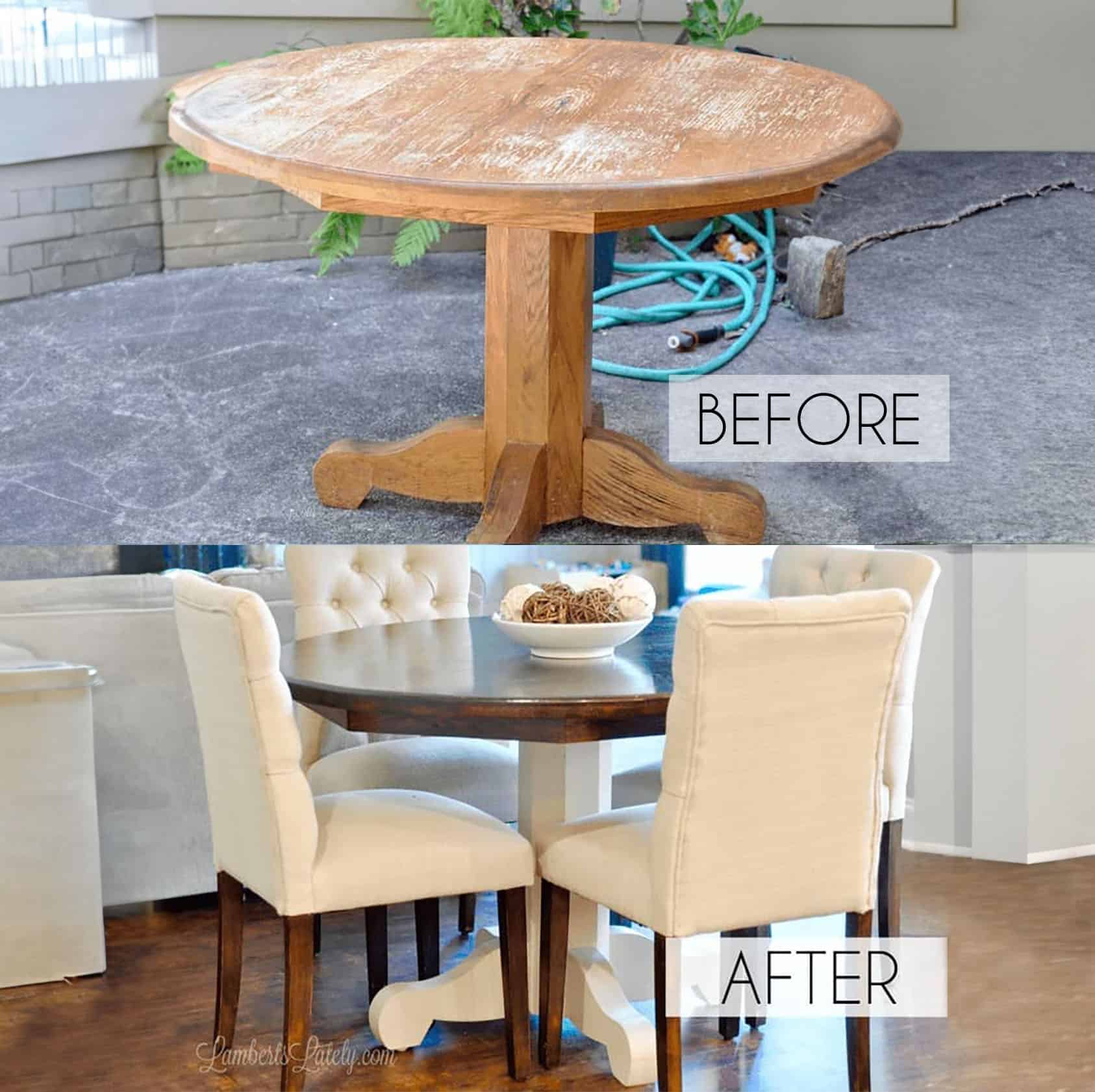
Paid links used in this post. Read more about my link usage policies.
A few years ago, I took a family heirloom from this...
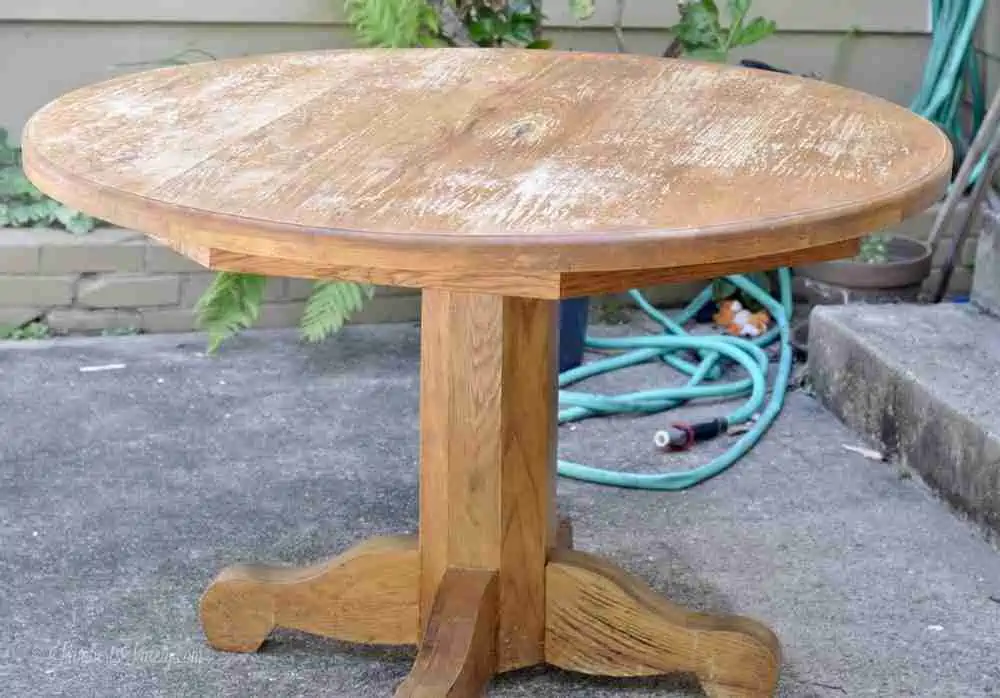
...to this.
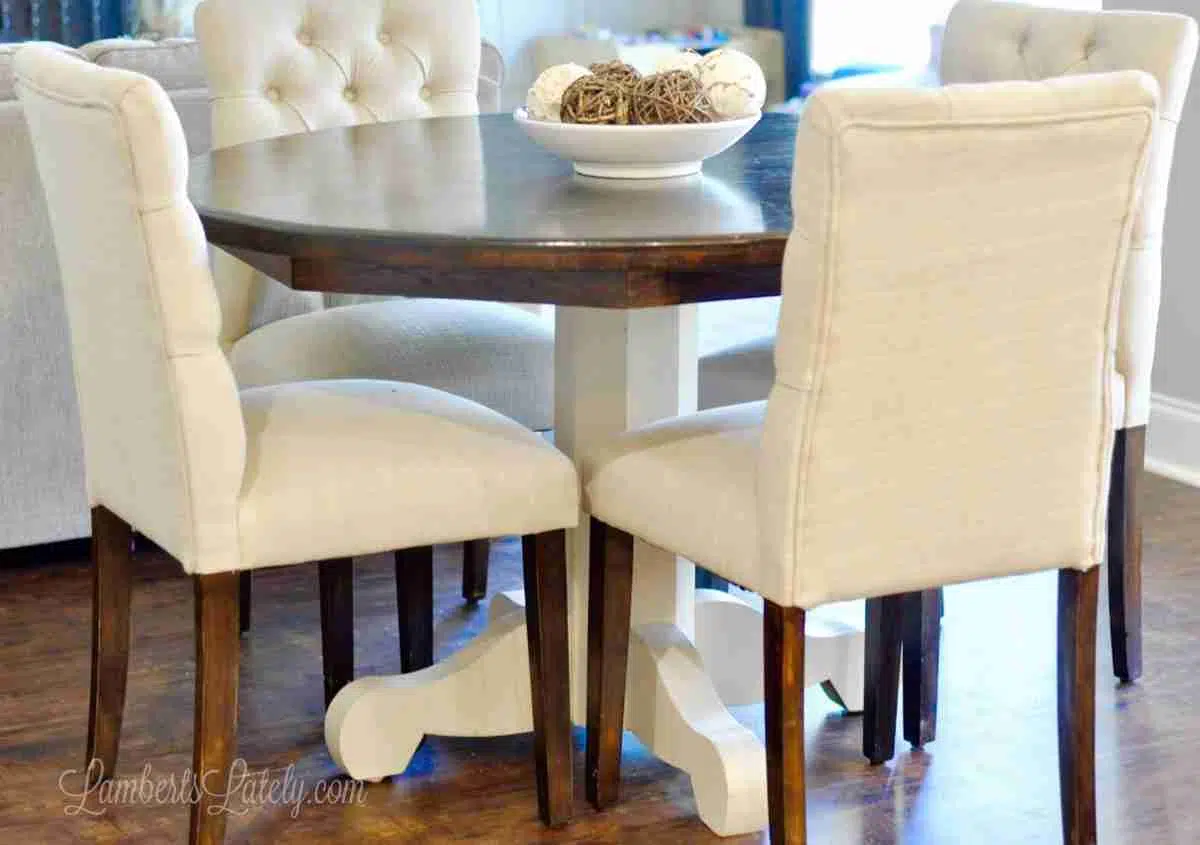
I had never refinished a piece of furniture in my life, so this was a definite learning experience.
In the original version of this post, I walked everyone through the process of refinishing this table, from stripping to varnishing. It has over 100,000 views as of right now, so I'd say it helped a few of you too!
But...it's been almost 7 years since we completed that first refinishing project. We use this table almost daily, so it has a little wear.
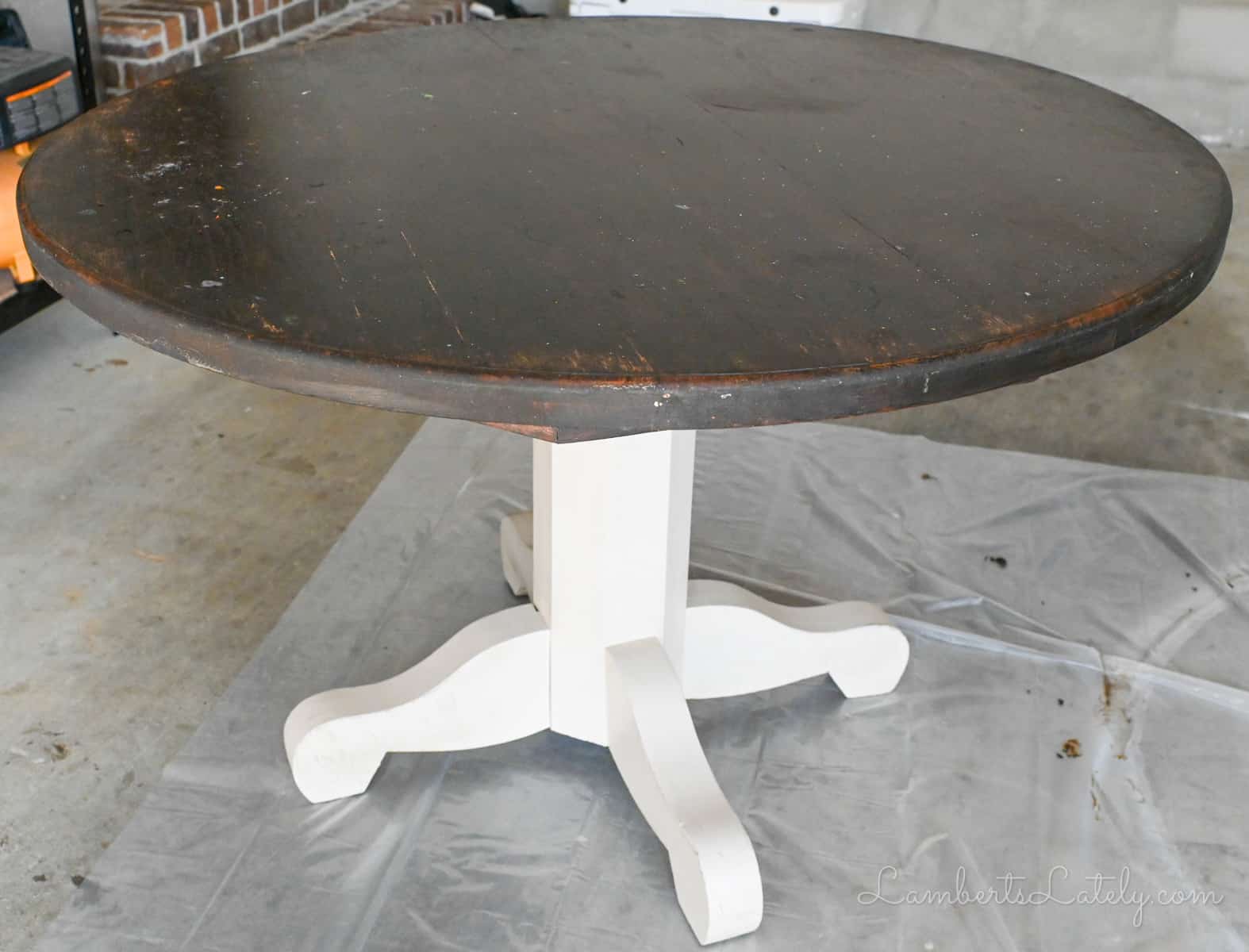
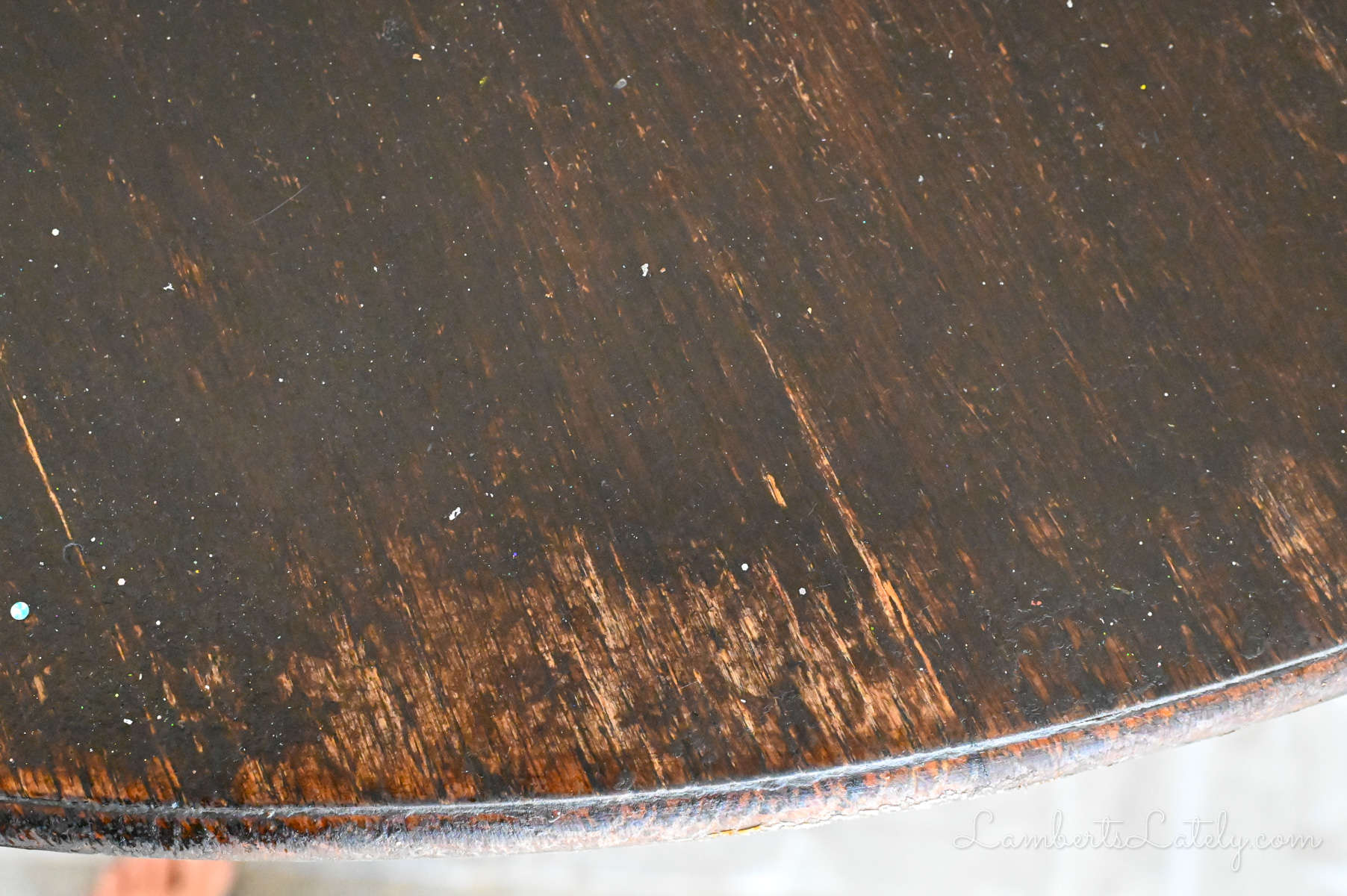
It was past time to give it a some TLC.
When we first refinished this wood table, we didn't really have to do much in the way of stripping any original finish. This time, we absolutely did.
We wanted it to look the same as it did the first time we refinished it, which meant completely stripping the old finish off of the tabletop and evening out the stain before we could add more.
I thought this would be the perfect opportunity to update this post with a more detailed look at how to strip down and refinish a table to give it new life.
Let's get going!
Supplies Needed to Refinish a Wood Table
Materials
Drop cloth
Stripping agent (I used Citristrip - much more detail about that below)
Putty Knife
Mineral spirits
Paintbrush
Scrub sponges
80-Grit Sandpaper
Stain (we love Minwax Dark Walnut)
Sponge brushes
Old t-shirts/rags
Polyurethane
Paint of your choice (if using in addition to stain)
Rubber gloves
Tools
Orbital sander (not required, but very helpful)
Step 1: Strip any existing finish on the table.
First thing's first - put a drop cloth under your table. This is a messy project! It needs to be completed in a well-ventilated area, like a garage or a covered porch.
Because we used both stain and polyurethane the first time we refinished this table, they had to come completely off before we could add anything else. Think about it this way: if you have chipped, old fingernail polish, can you just paint over it? Sure, but it's going to look uneven and messy.
Same with a wood table. The furniture has to be stripped down to the bare wood before you can add anything else to it.
There are a few ways to do this. You could just sand it down to the wood, but that would take a really long time. We chose to use a chemical stripper to easily take the finish off of the wood.
Comparing Chemical Stripping Formulas - Which is Best?
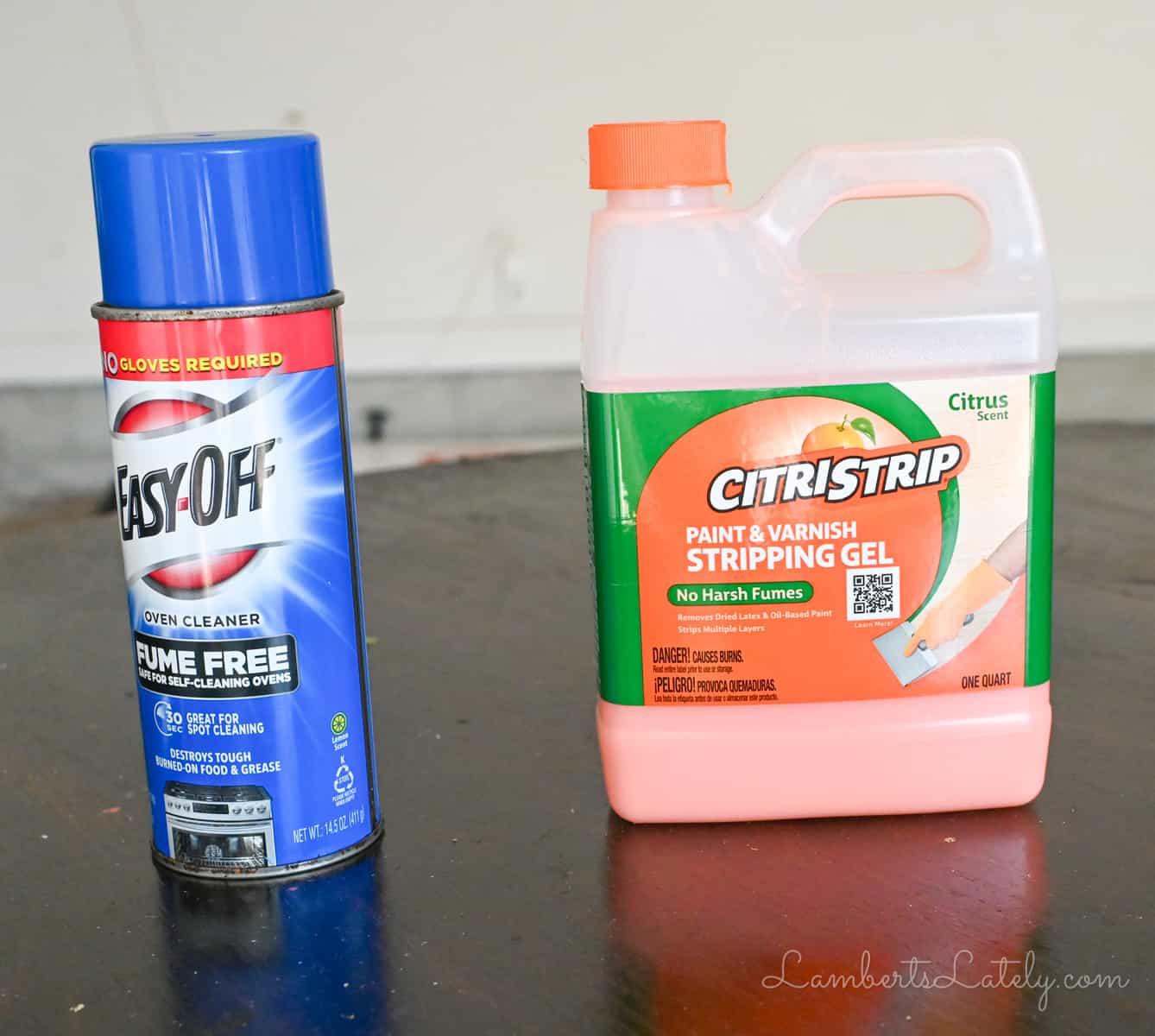
I wanted to do a little experiment. I had read that you could use oven cleaner to strip wood and was super intrigued. So, I bought a traditional stripping gel and a bottle of oven cleaner and coated half of my tabletop in each.
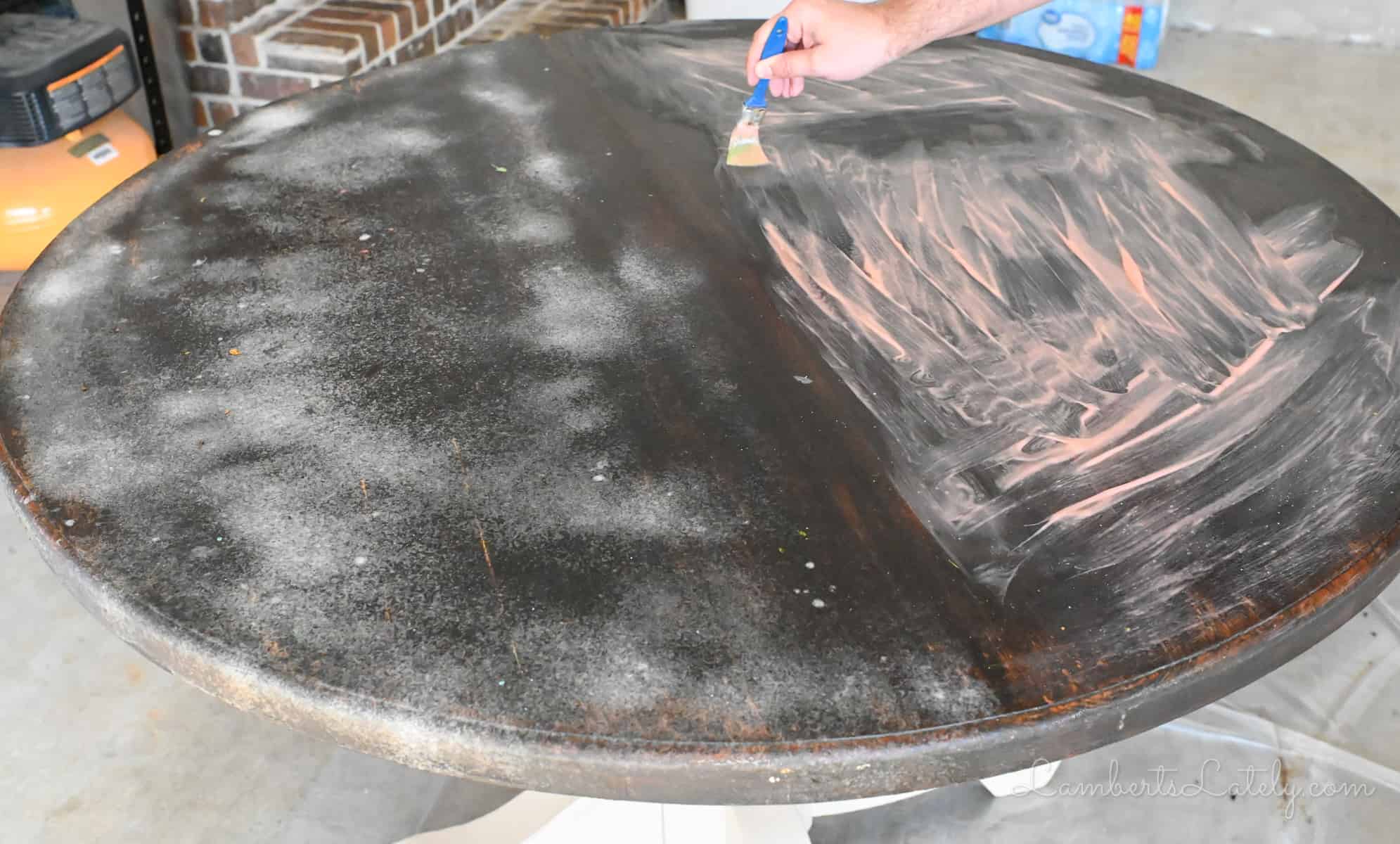
I let these sit for an hour or two, then tried to scrape off the finish with a putty knife.
Here are the results...
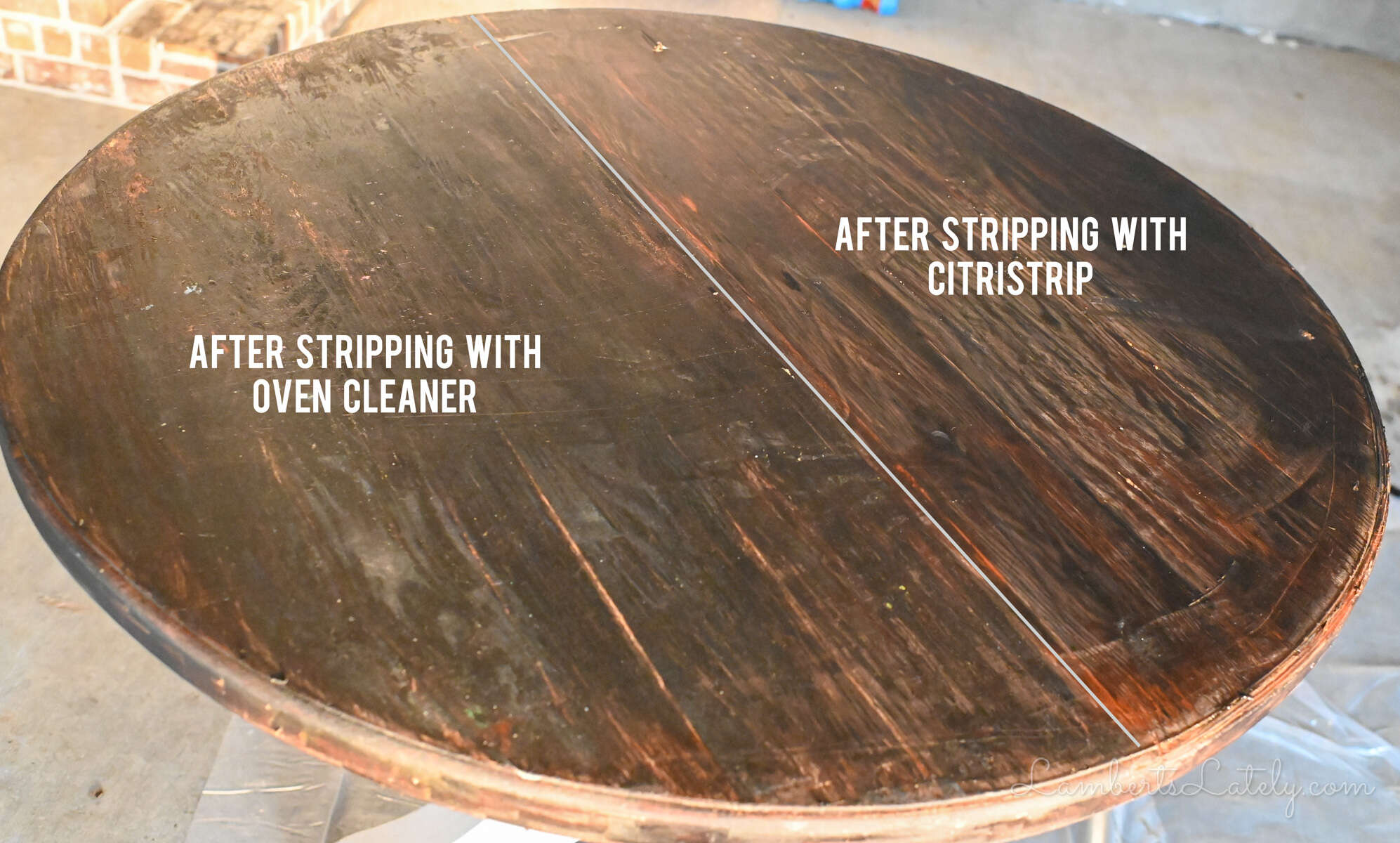
I really wanted the oven cleaner to work because it's a good bit cheaper than the stripping gel, but it just didn't. Sure, it took some of the finish off, but the stripping gel was significantly more effective.
Trust me, go with the Citristrip.
How to Use Stripping Gel
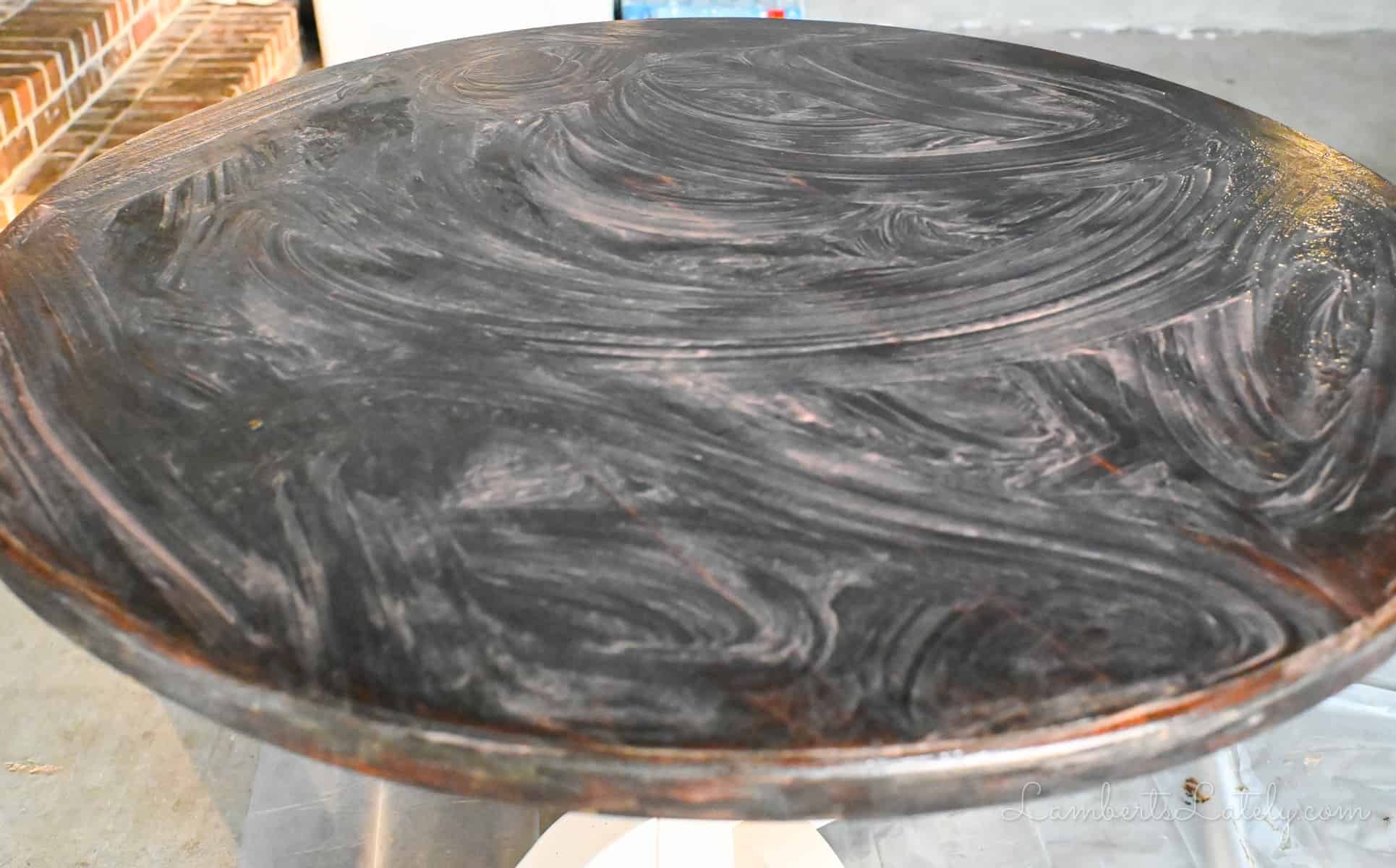
After that, we coated the whole table thoroughly in just Citristrip to take it down to the bare wood. This process is pretty simple - paint a generous layer of gel onto any wood that you need to strip. Let this sit for at least an hour or two (overnight is even better).
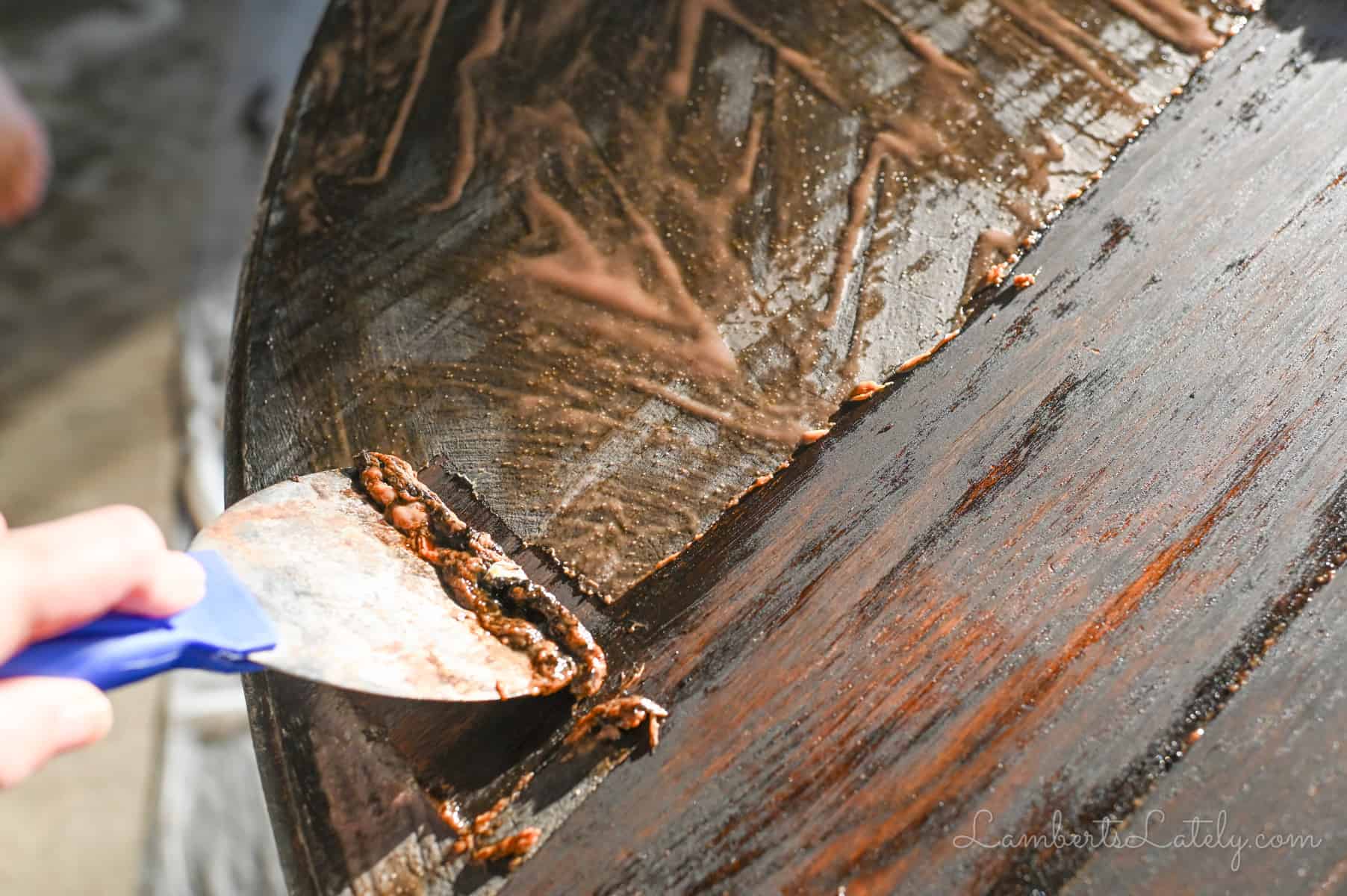
Once it's marinated a little bit, use a putty knife to scrape off as much of the gel as possible. Only scrape as deep as the gel, not actually getting into the wood so you don't damage it.
I'll warn you - this is gross. Not only is that gel going to come up, but any finish/stain that's on the surface of the wood will come up with it. I recommend having some kind of disposable plastic cup to scrape the gel into as you take it off the table - it ends up being a lot of gel!
How to Clean the Wood After Stripping Finish
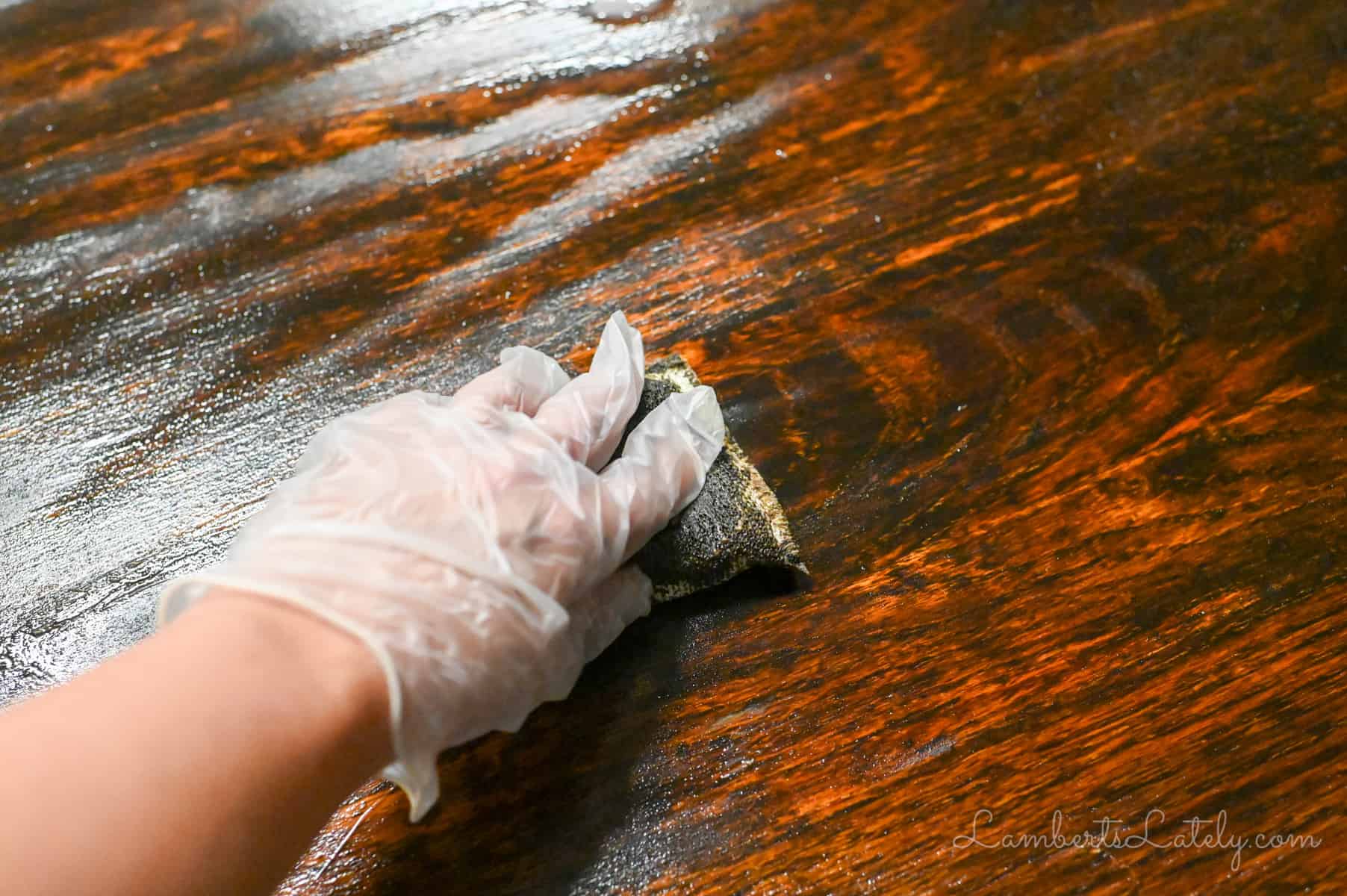
Once as much of the gel is off the table as possible, liberally brush mineral spirits onto the table to get any remaining gel off. I brushed it on, let it sit a minute, and then used a scrub sponge to really get in there and clean the wood.
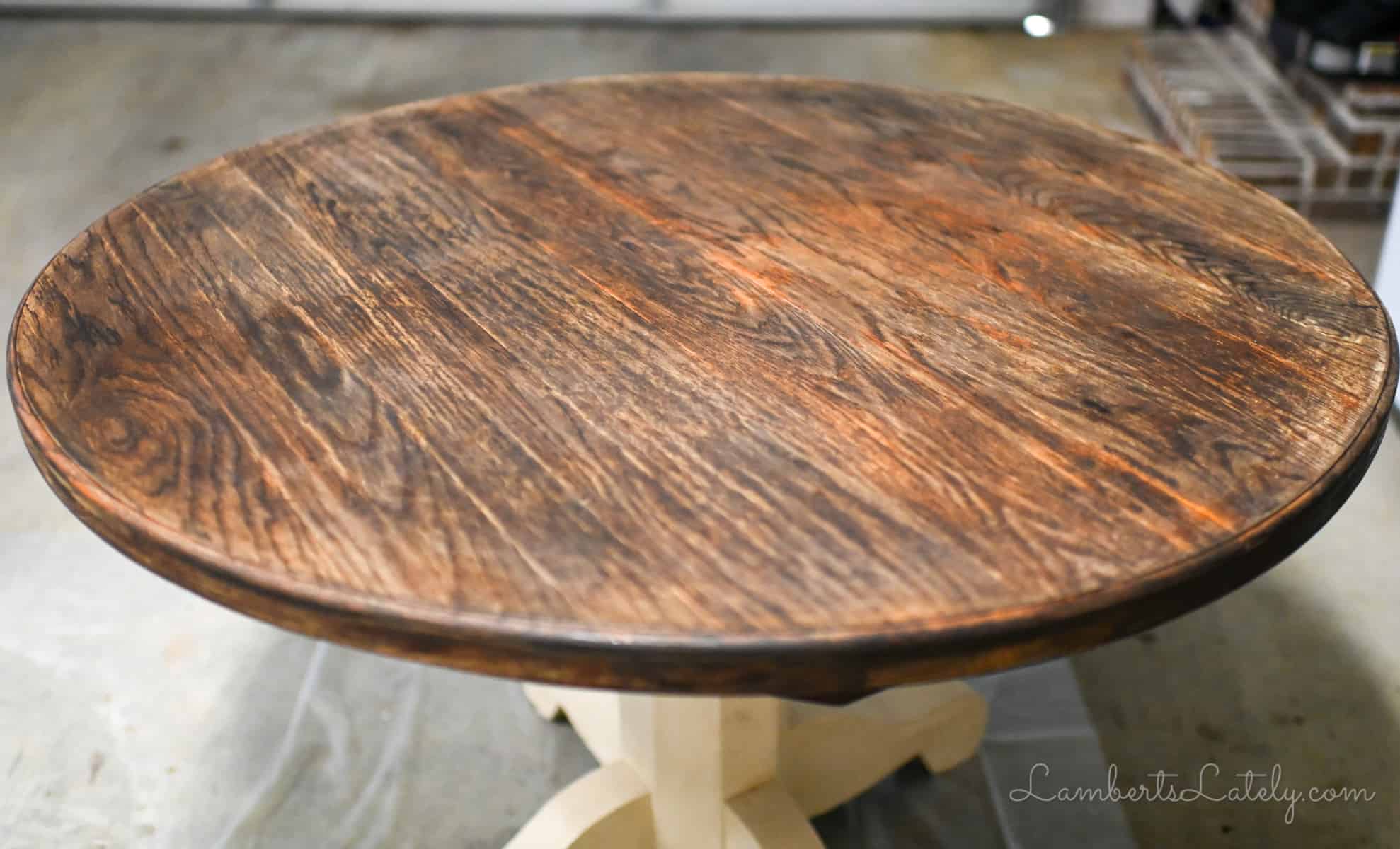
Let the wood dry for an hour or two. If you still see any shine from the polyurethane/varnish or paint on the wood, repeat this stripping process. You might have to complete this step a few times to really get everything off of the table (we had to do this 3 times).
Removal Tip
Any stain will get really deep into the wood, so it's almost impossible to get it completely out (especially if it's a darker stain like we used). You can see that the stripped table above is in no way the same color as the original table. However, this is down to the bare wood - any deeper would have eaten into the actual wood of the table.
I would think twice before trying to refinish dark-stained wood with a light stain...it's difficult! But this is totally fine to do if going from a lighter to a darker stain, or if you're refinishing the same color as we did.
Step 2: Sand the table thoroughly.
Next, use sandpaper to remove any leftover finish you didn't catch. You can start with this step if you don't have any heavy-duty finish on the table (this is where we started the first time we did this refinishing project).
Coarse Sand
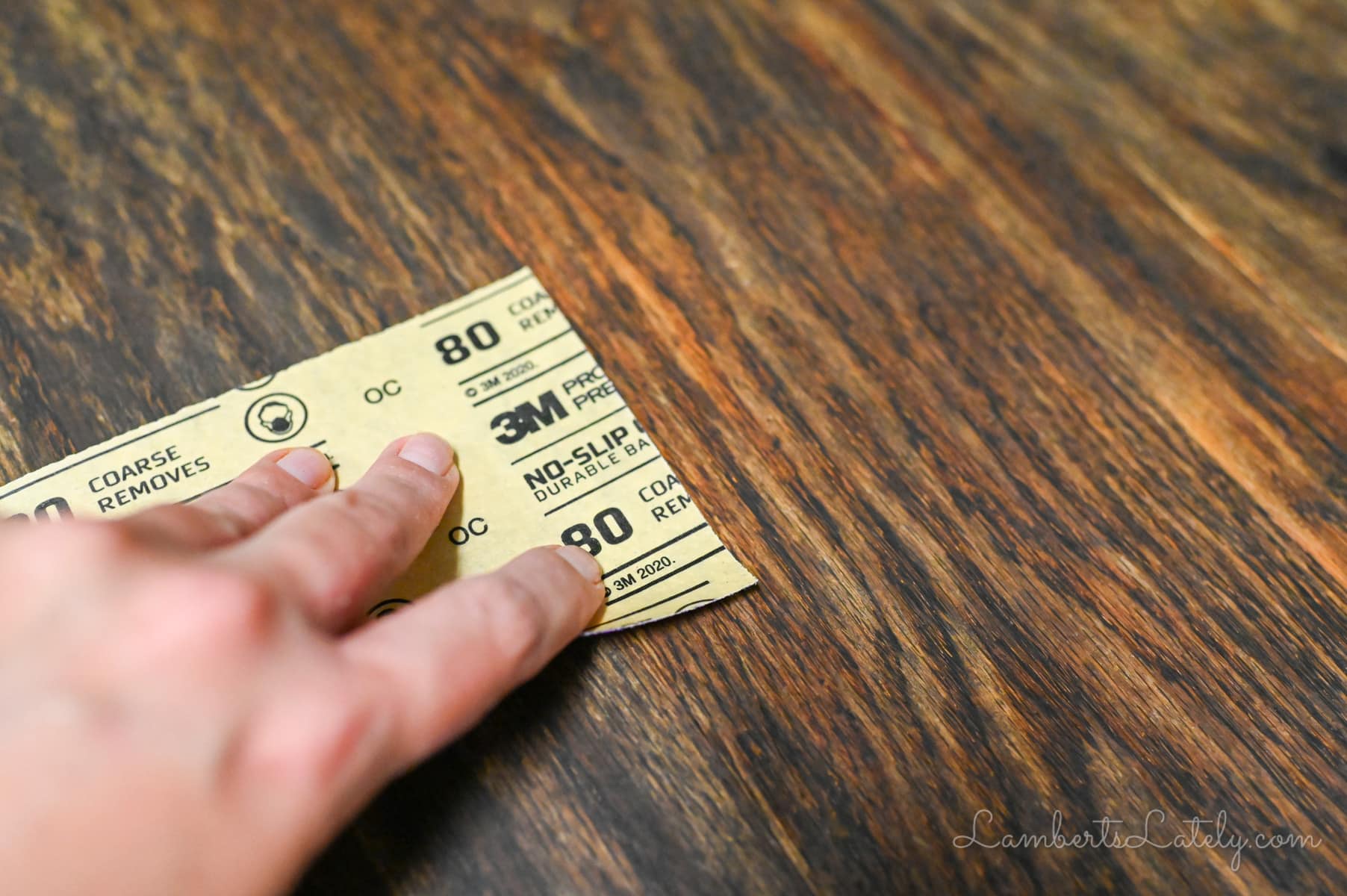
Start with a coarser piece of sandpaper (we used 80 grit). We chose to do this part of the sanding process by hand to avoid damage (since this is a stronger grit of sandpaper). If you're super confident with an orbital sander, by all means, use it!
Sand your table with this coarser grit until you see no finish coming up on the sandpaper.
Fine Sand
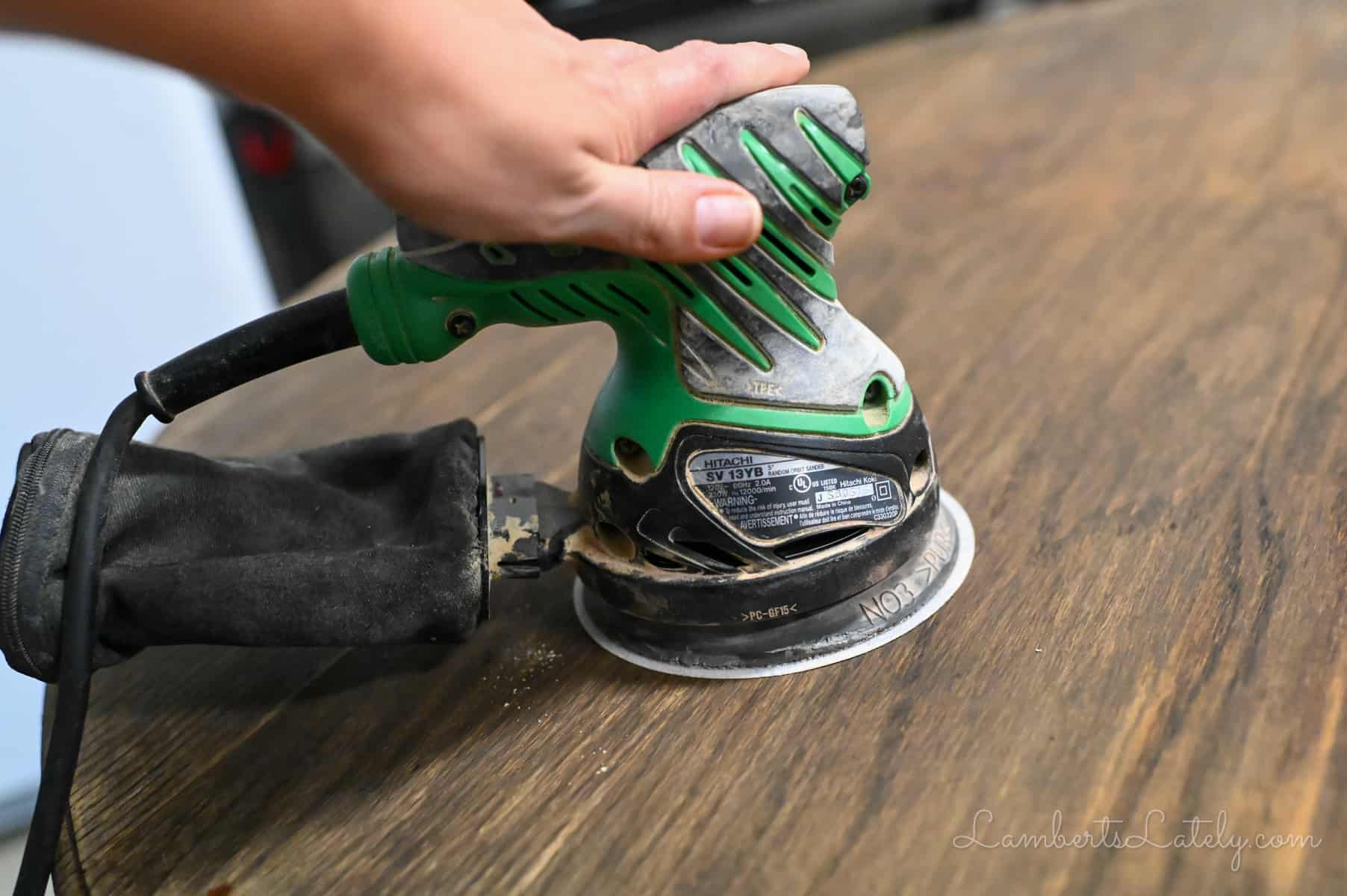
Once we were sure that almost all of the finish was removed, we used an orbital sander with a finer grit (180 grit) to smooth out the wood. Do this on every surface until no finish is coming off of the table and the wood is smooth to the touch.
I wouldn't say it took terribly long to sand the table...maybe 2 or 3 good passes. Expect to do at least 3 or 4 passes if you haven't chemically stripped the table already.
After sanding well, you want to be able to look at the wood at any angle and see no stain or paint finish. There shouldn't be a glow or remains of paint on the wood, no matter how you look at it.
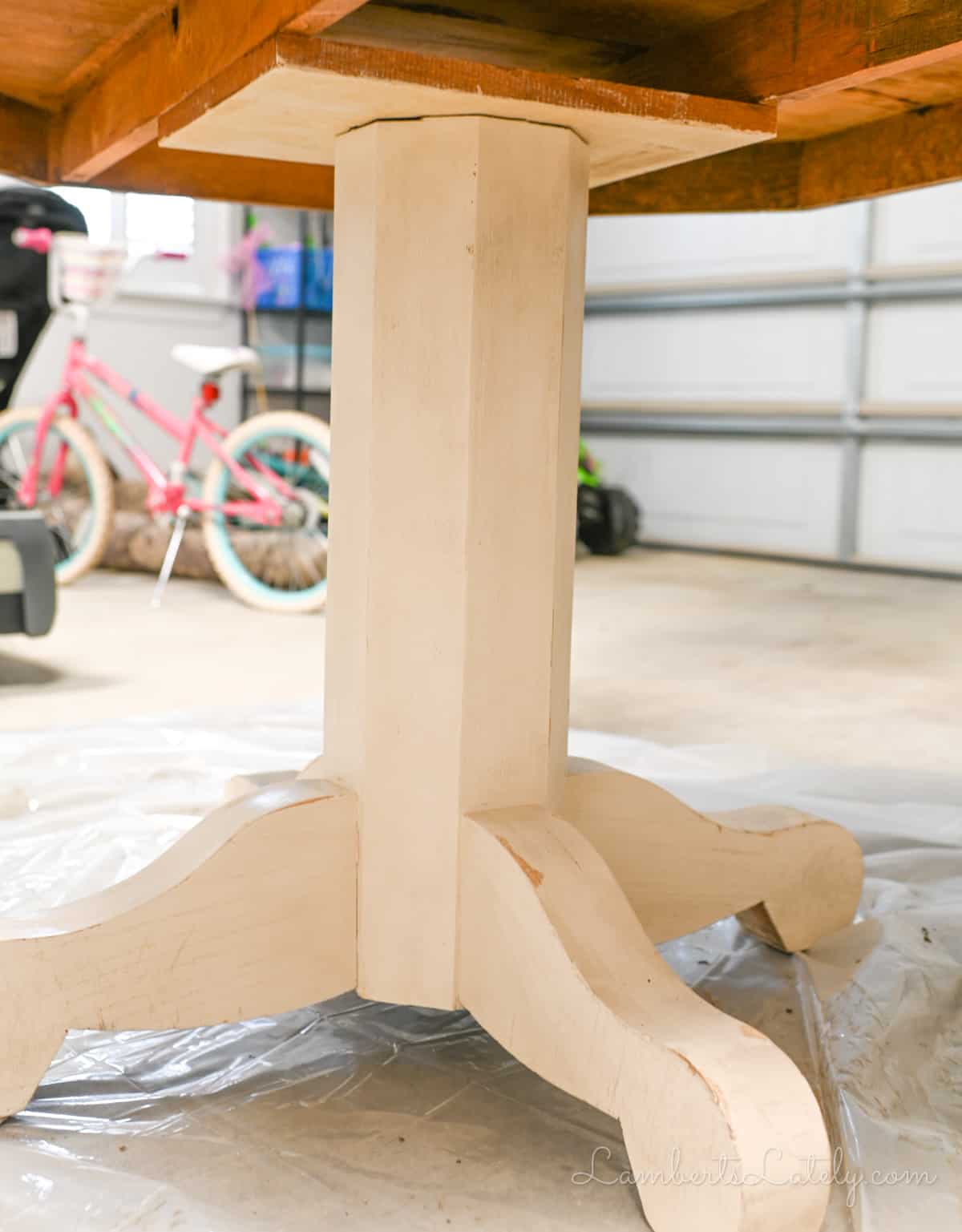
I also gave the painted base of the table a light sand at this point to just get any loose paint off. We were taking it back to a similar paint color, so there was no point in completely stripping it. If you are stripping your table base, of course this whole process needs to include that base as well.
Step 3: Prepare for finishing.
The goal of this step is to get rid of any dust and to make sure you're really down to the wood you're trying to finish. Take an old kitchen rag, wet it well, and really scrub every surface that was sanded. Make sure you get any sawdust out of the little cracks in the wood.
Allow the wood to dry for a few minutes, then go over the surface (against the grain) with your hand. The wood should feel smooth to the touch and you should feel little to no grain in the wood. You also shouldn't feel any lumps or bumps from leftover polyurethane.
As long as the wood feels smooth, you're ready to move on!
Step 4: Paint or stain the legs.
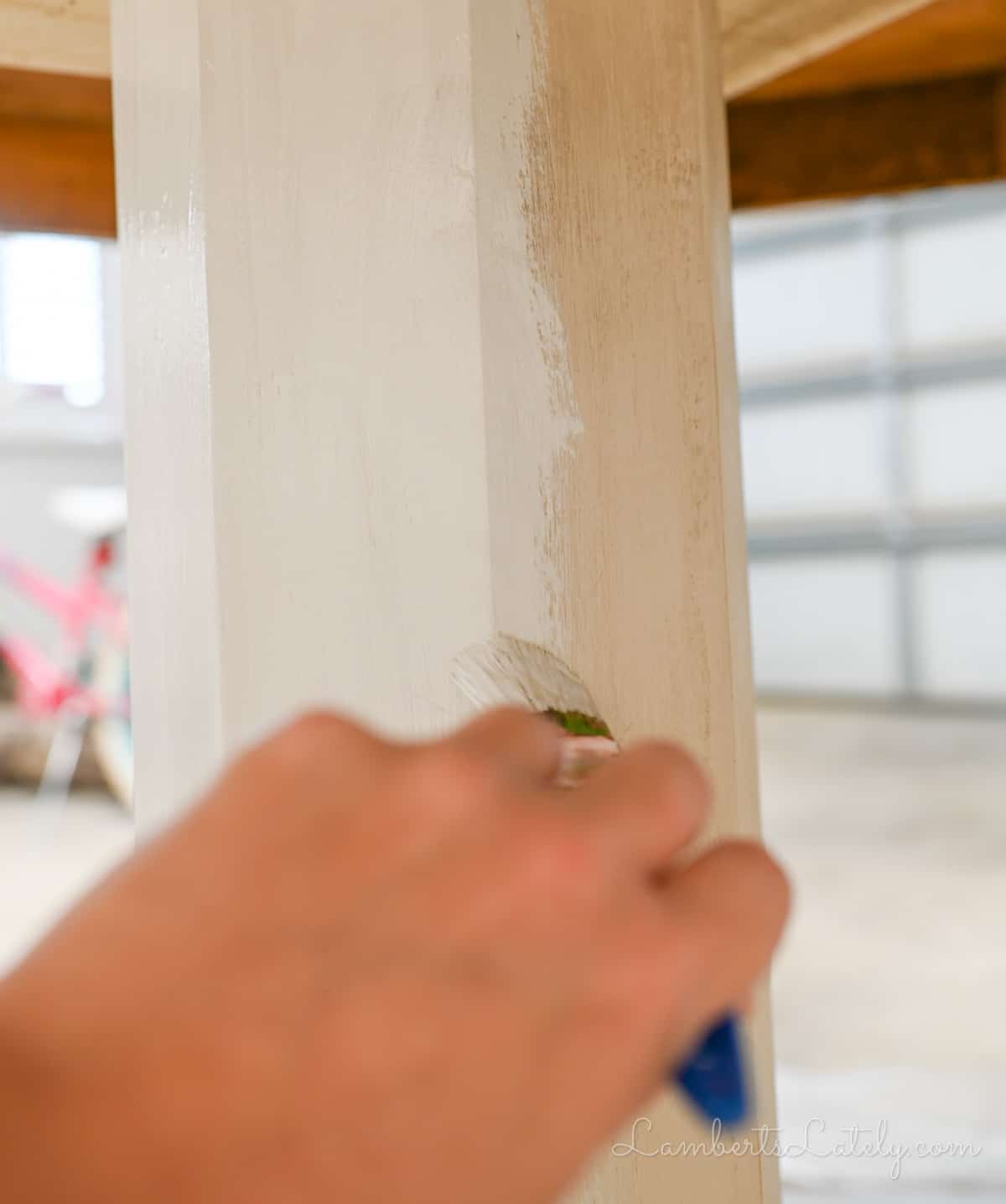
While the table was still disassembled, we painted the legs with a solid color (I wanted to keep that farmhouse look of a solid base with a stained top).
I used the color Agreeable Gray (colored into another brand's actual paint) for this part...I wasn't all that picky about the color of the base, I just knew I wanted something off-white, and Lowe's had this paint in a sample can (which was the perfect size for this project).
Step 5: Stain the tabletop.
If you disassembled your table, I'd recommend waiting until your base is dry before you start the stain. It's much easier to complete this part if your table is completely reassembled and standing on its own.
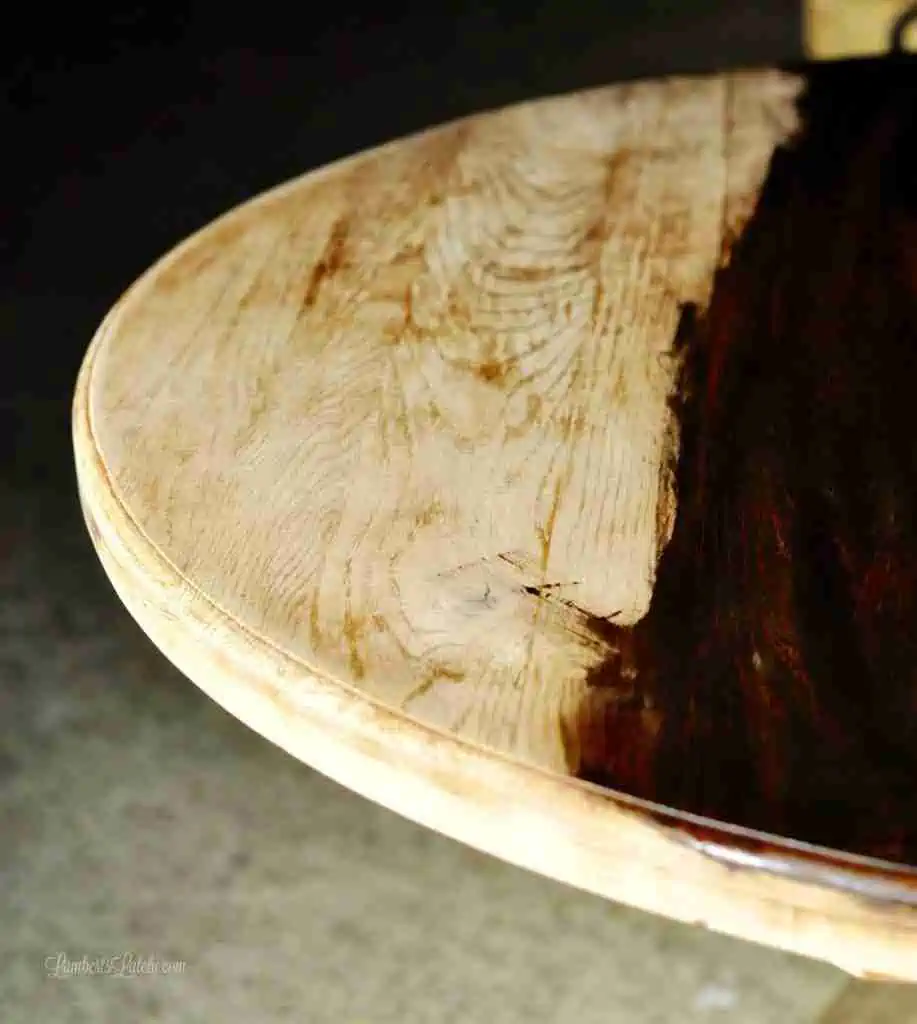
The stain color we used for the tabletop was Minwax Dark Walnut...it's my favorite stain color ever! I've used it in so many different projects now, like my sofa table and my console table. It's so versatile - depending on how much stain you use, you can go from an orangey brown that shows a lot of wood grain to a deep (almost black) brown.
This is an oil-based stain, so remember that it will need to be used in a well-ventilated area and won't come out of clothes easily. The half-pint can should be more than enough for a table.
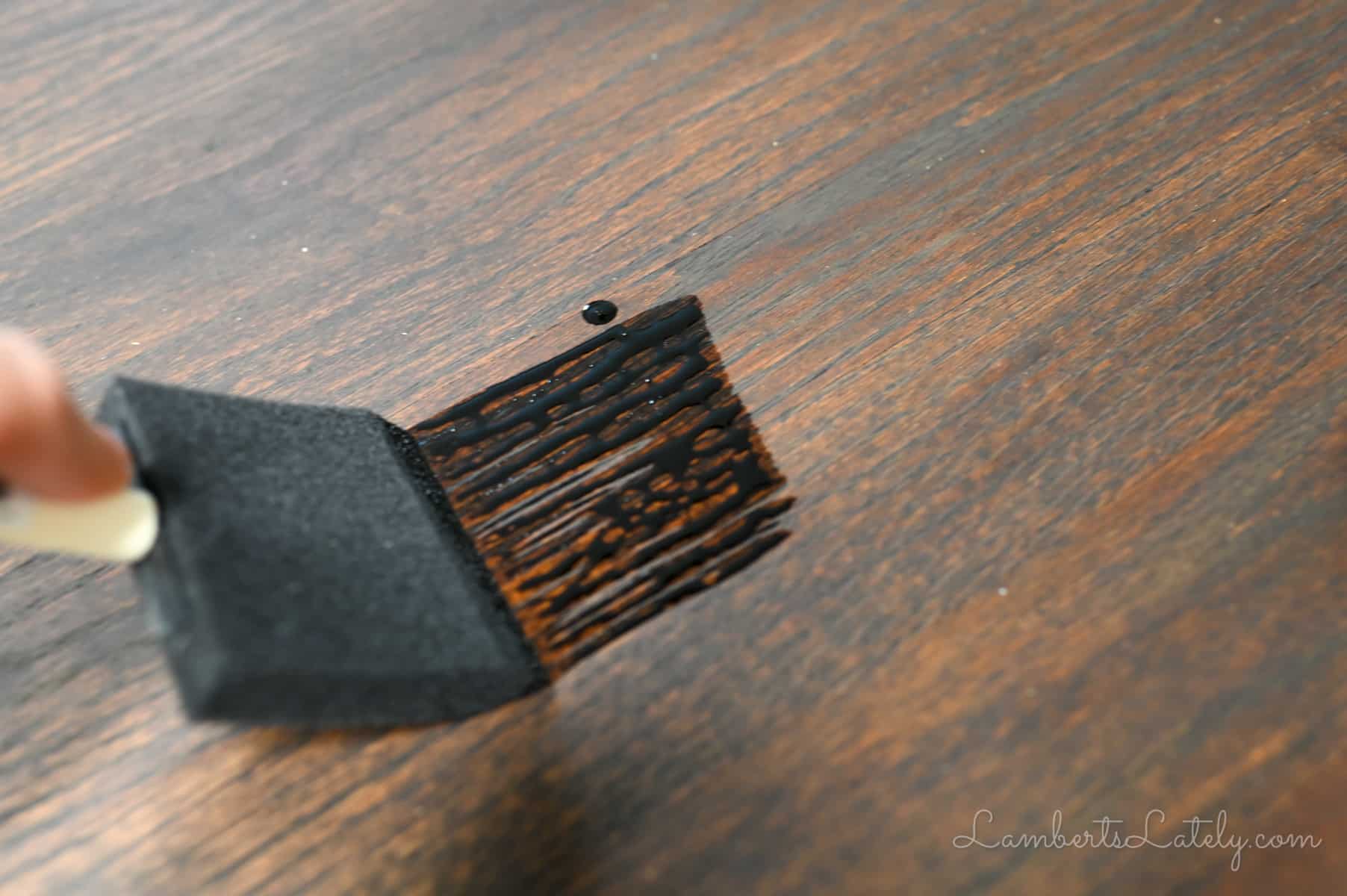
I prefer to apply my stain with a cheap sponge brush - that way you can just throw it away after the project. Apply in strokes that go with the grain of the wood, just coating the top. It should look painted but not wet if that makes sense. If your stain is pooling on the table, it's too thick.
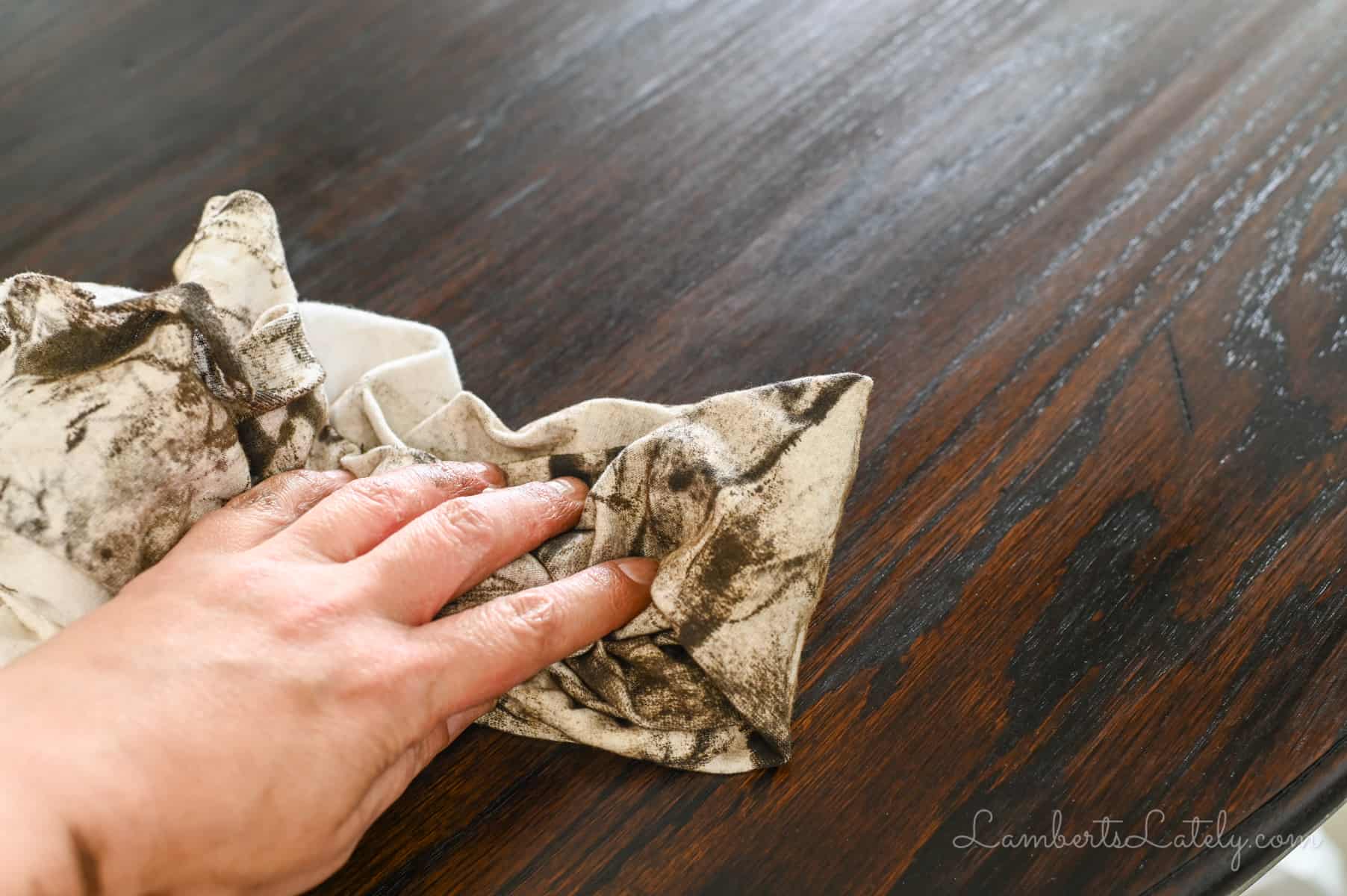
Give the stain anywhere from 10 minutes to a couple of hours to set, depending on how deep you want the color. Then, use an old piece of cloth to wipe off any excess. I like using an old t-shirt or an old rag to do this. You will definitely need to throw the cloth away afterward, so don't use anything you value!
Wipe with little pressure - just enough to take the stickiness off of the table without compromising the stain.
After wiping it down, allow the first coat of stain to dry for at least a couple of hours and repeat the process until the stain is as deep as you'd like it to be.
You'll notice that the stain dries much lighter than it looks when first applied, so don't freak out if it looks super dark when you put the first coat on! I had to do 3 coats of stain to achieve the depth I wanted on my tabletop.
Once your final coat of stain is applied and wiped, allow it to dry for 24 hours before moving on.
Step 6: Protect the wood table.
If you'll be using the table often, you'll want something that's going to protect the finish and be super easy to clean.
What Finish to Use
I like using a water-based polyurethane to finish my wood furniture. You can use this without a ton of ventilation, it's more forgiving than a lacquer, and it provides just as much protection as an oil-based polyurethane. Using a water-based finish will also make clean-up much easier.
I used Minwax Polycrylic in clear gloss for this last step. The half pint of this should be plenty if you're only applying it to the tabletop. I also use foam brushes for polyurethane application.
How to Apply Polyurethane
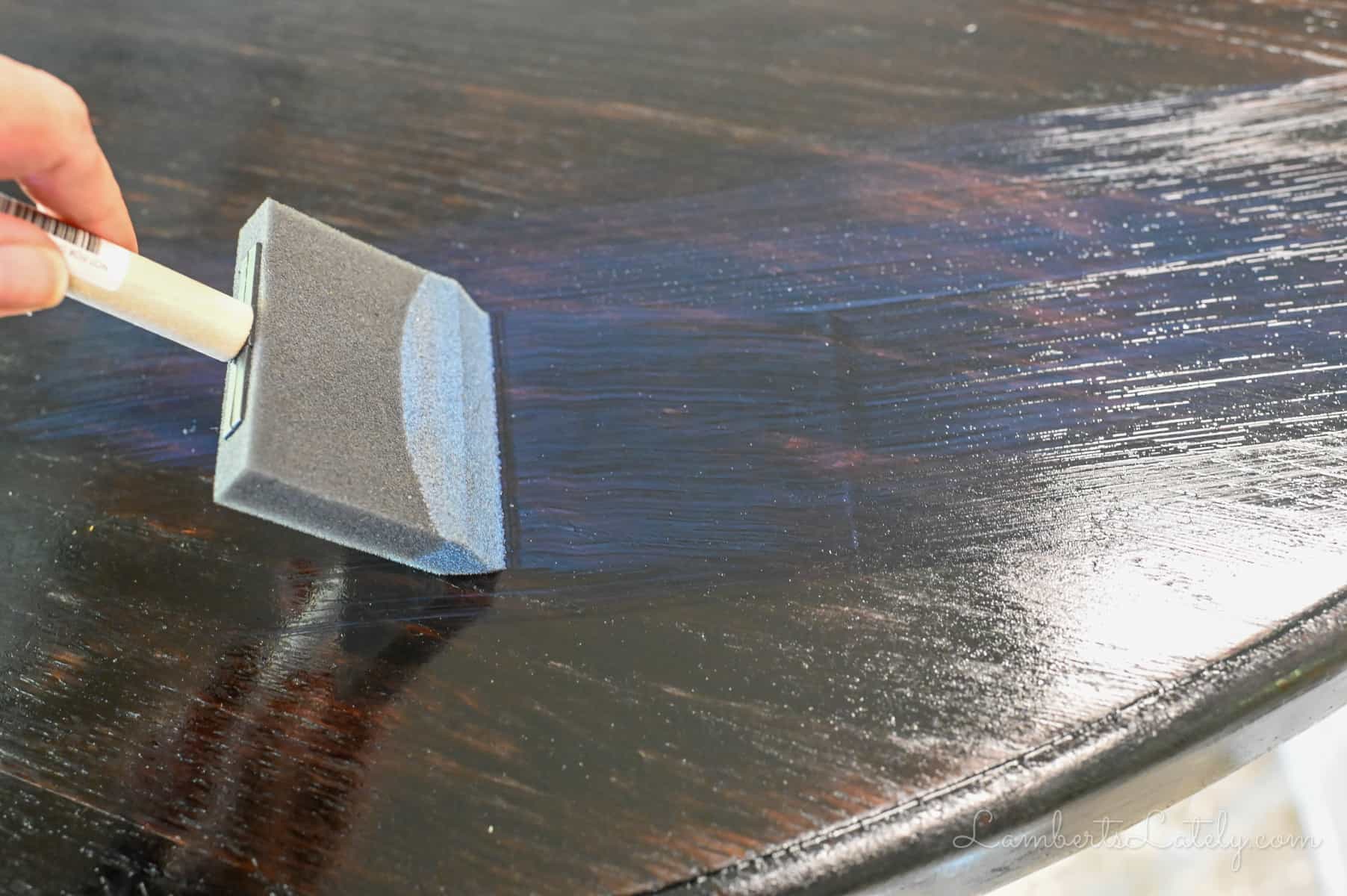
I like to pour a little bit (think like ¼ cup) of polyurethane onto the table and spread it evenly in the direction of the wood grain with a sponge brush. Use light strokes to make sure there aren't any hard brush lines.
The polyurethane goes on a little cloudy, which is totally normal...the finish will dry clear. Nevertheless, you'll want to apply in very thin coats.
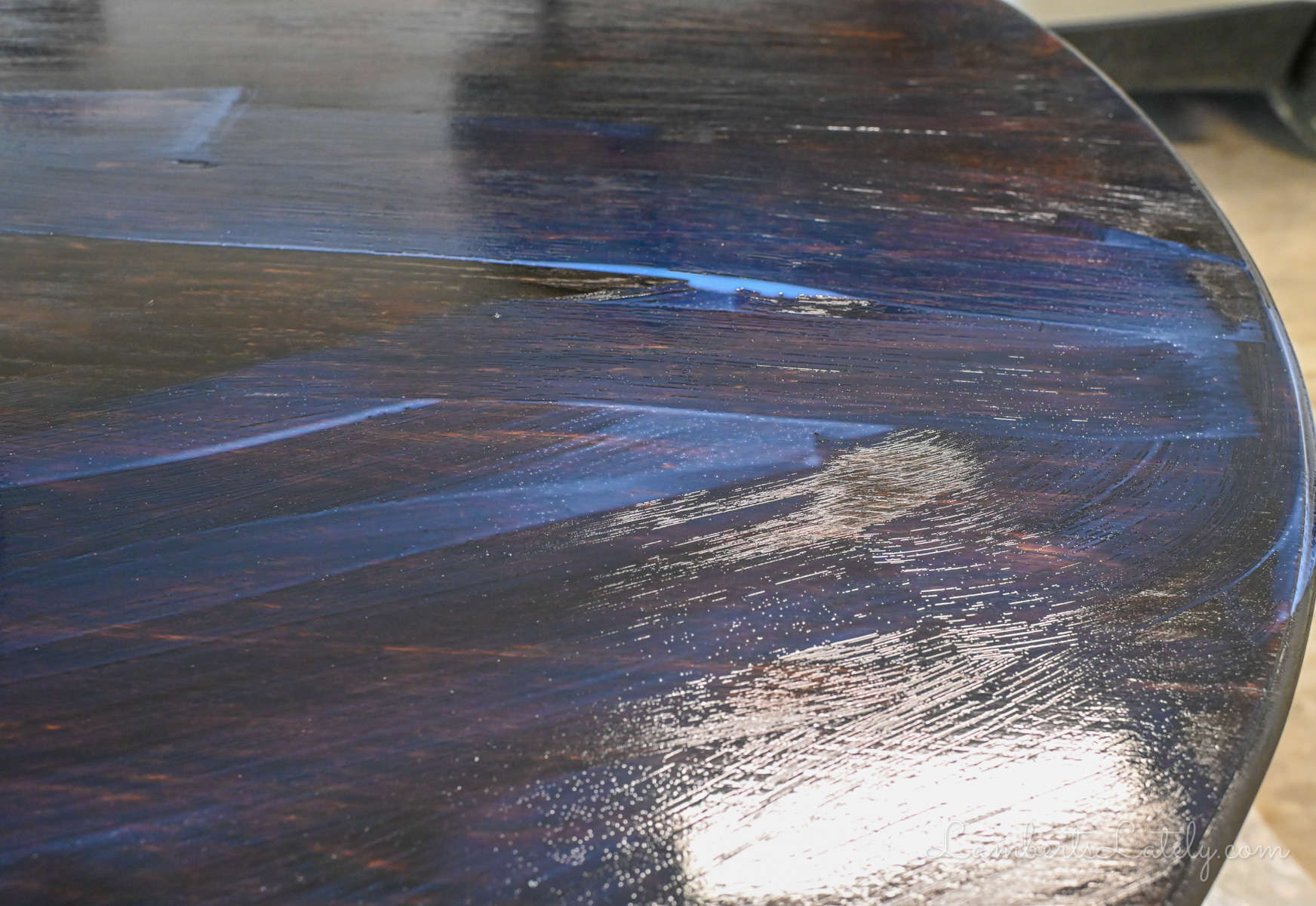
If your polyurethane has a blue tint (like the image above) after it's spread, it's too thick!
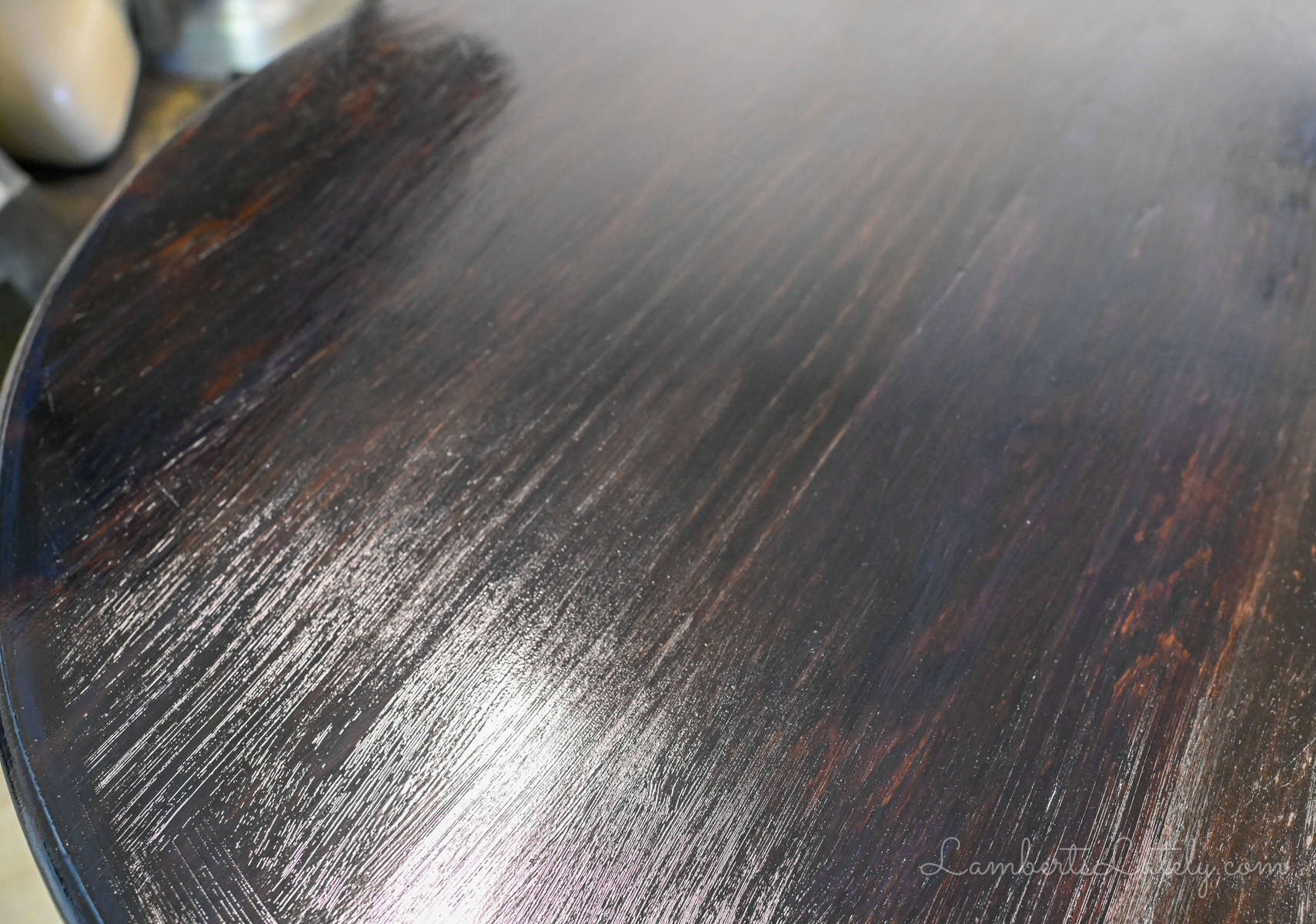
The wet polyurethane should look more like this - still a little cloudy, but without that blue tint and evenly distributed.
Give each coat a couple of hours to dry before applying other coats as needed, giving the table a sand with a fine-grit sandpaper between each coat.
Don't be surprised if you have to apply more coats of the polyurethane than expected...especially for a high-traffic table, you'll want to apply a few. The manufacturer recommends 3 or 4, but I had to apply 5 to really get the texture and finish I wanted for a kitchen table.

After allowing your last coat of polyurethane to dry for 24 hours, your table is ready to use!
Daily Maintenance Tips
- Don't use harsh chemicals to clean the table. It's best to use something like soap and a little bit of dish detergent for daily cleaning.
- Don't scrub too hard. The polyurethane will come off if you're using a brush that's too coarse or if you're scrubbing too hard. Keep it gentle!
- Don't let moisture sit on the table. If you notice a water ring or spill, clean it up immediately.
More Helpful Tips & Tricks
- Timing: Expect this whole project to take about a week. You're only going to need a few hours of actual work to get it done, but between the stripping process and applying the new finish, there are lots of setting and drying times.
- Expense: This is a relatively inexpensive project. If you have to buy all of the materials (I'm guessing you already have some of them), I would estimate the cost to be as low as $50.
- Don't make the same mistake I did - use rubber gloves! I know you see me without them in a lot of these pictures, but I regret not wearing them the whole time. Some of these chemicals are harsh, and the stain is tough to get off your skin.
- If you're doing this project outside, try to shield the table from the elements. Bugs, pollen, and leaves can get stuck in the wet stain/polyurethane and really mess up your project. If you can put up a tarp or screen to keep away any debris, it helps a lot.
More Furniture Projects
I can't wait to see your gorgeous tables! If you follow this tutorial, make sure to tag me (@lambertslately) on social media with your pictures. And you can leave your best refinishing tips and tricks below!

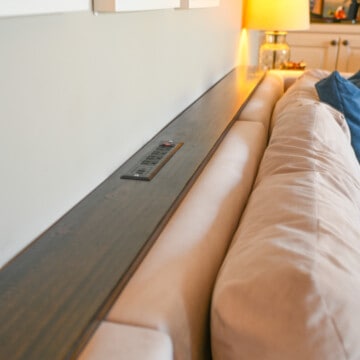
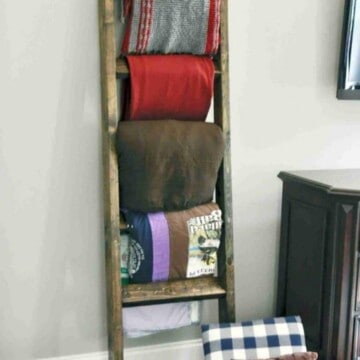
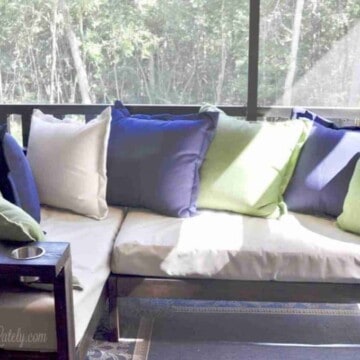
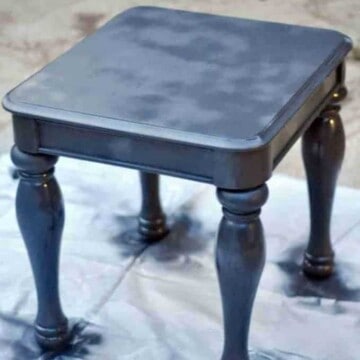
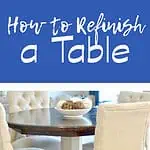
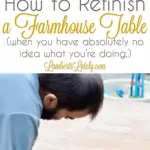
How wonderful to update something... and have the project turn out nicely. 🙂
It turned out fantastic. I've done a few tables and they can be tricky.
I love old furniture and having a family hand-me-down makes it even more special.
Very nice transformation!
I love this post. I'm hoping to find an old table for my breakfast area and redo it, so your post was very helpful. I love the curves on the table too. It turned out great. Thanks for sharing on Sunday's Best.
Nicely done! It's nice you were all able to help in updating your table. I hope it brings many more years of use in your kitchen. Thanks for sharing with us at Creatively Crafty #ccbg 🙂
Thanks, Lydia!
Your table looks lovely. I am so happy to see you restored it. it looks like it will get you two for seveal more years.
Thanks so much, Christine!
Hi Leslie! I have always wanted to do this. Thanks for the easy DIY instructions, can't wait to give it a go. The table looks beautiful! You have been featured this week at Dishing It & Digging It. Thank you so much for sharing with us 🙂
Thanks so much for the feature! 🙂
Beautiful...and you have such a pretty helper!
Aww thank you!
Looks beautiful, but after all that work I was hoping for more after pictures!
It's currently sitting in my cave of a kitchen where the lighting is terrible...hoping to get some updated pictures up of it when we move in a couple of months!
Awesome post! I’ve been thinking of refinishing my table, and this tutorial is perfect! Can I ask how well the tabletop has held up over time?
I have been absolutely amazed with how well it's held up! It still looks like new, even after wiping down almost nightly. The only issue I've had was really my fault...I worked on our Christmas wreaths at the table and the wire from the wreaths scratched it. Totally my fault, I wasn't thinking!
Thank you for sharing. I purchased a round dining table second hand to refinish and followed you steps. This was my first project and your instructions were perfectly helpful. After all the coats of the polyurethane, was it completely smooth?
I'm so glad I could help! I wouldn't say it's 100% smooth - it still has a tiny bit of grain to the touch, but definitely smooth enough to keep clean for a kitchen/high traffic table.
It's a great work that is done by you. It's look beautiful and i just like your work skill. I have a old kitchen table and i have been thinking to refinish it hopefully your tips are helping me. Thanks for the sharing your great experience with all of us.
Can I ask what type of paint you used in the legs? Satin, flat, semi-gloss, or gloss. I am going to attempt the same process on a beautiful solid oak table we have and was going to paint my legs and chairs black. I read several sites that say to use chalk paint on the legs and chairs and put a gloss finish in them as well for durability.
I used a semi-gloss on mine audit's held up well (it was Valspar, I'm not sure of the specific type). I thought just using a semi-gloss was much easier than chalk paint, but if you're wanting a more weathered look, chalk paint is definitely the way to go!
What a nice thing to have that table from so long ago. One tip, you don't have to sand the pieces of wood you will paint. Just give it a good wash with soap and water and use a primer, then good quality paint over. The table is beautiful.
Great idea to try next time...thanks!
This is great! Can I ask - do you remember - you said a half pint would be fine to do just the tabletop - I'm going to do my table but it'll include the base/legs as well. Think a half pint is still enough?
If I remember, I had plenty left that could have been used on legs. You should be fine just getting a half pint!
Thank you for the very detailed steps on how you went about this. I have wanting to redo my kitchen table and chairs since we moved into our new house but have been to scared to try and not willing to pay someone else to do yet at this point. With these details, it is looking like this is going to be attempted yet this fall!!
You are very welcome...good luck to you!
Thanks for taking time to give us your tips! I'm curious about the base holding up to getting kicked and a broom/mop/vacuum being smacked into it?
It's actually doing pretty well! I do clean it once a month, and that takes most of the scuffs off. No paint chipping to report yet.
I have an oak table this will be perfect for! Where are your chairs from? I love the whole look!
Thanks...they are Target! I linked them just now at the bottom of the post (they're called Brookline Tufted).
I like that you have chosen two colors for refinishing, it looks fantastic with your chairs.
Thank you!
This post is exactly what I need! So happy it was the first in my google search. Thank you for the clear step by steps! Can’t wait to start my project.... I scored a beautiful farmhouse table and chairs for $125!!
I hope it helps - best of luck to you!
Do you use polycrytic or polyurthan on top of stain
I used the polycrylic pictured above.
Nice job on the restoration! Have you ever seen the restorer?
Not sure what you mean - could you explain?